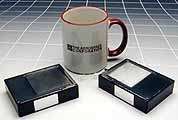| . |  |
. |
 El Segundo - October 11, 1999 - The picosat launch will take place from the Spaceport Systems International (SSI) Commercial Spaceport at Vandenberg. It is to be the inaugural launch of the Orbital/Suborbital Program Space Launch Vehicle developed by the Air Force Space and Missile System Center's Test and Evaluation Directorate at Kirtland Air Force Base. It also is to be the first launch from the commercial spaceport.
El Segundo - October 11, 1999 - The picosat launch will take place from the Spaceport Systems International (SSI) Commercial Spaceport at Vandenberg. It is to be the inaugural launch of the Orbital/Suborbital Program Space Launch Vehicle developed by the Air Force Space and Missile System Center's Test and Evaluation Directorate at Kirtland Air Force Base. It also is to be the first launch from the commercial spaceport.Orbital Sciences Corporation is handling launch integration for the Orbital/Suborbital Program, whose purpose is to achieve low-cost spacelift for small satellites. The program uses surplus Minuteman II solid rocket motors and upper stages derived from Orbital's Pegasus rockets. Satellite Classifications Satellites are classified according to weight. Picosats are under one kilogram (2.2 kilograms equal a pound), while nanosatellites range from 1 to 10 kilograms. Other classes are microsats, 10 to 100 kilograms; small sats, 100 to 1,000 kilograms; and standard satellites, 1,000 kilograms or more. The smallest category envisioned is the femtosat, less than one-tenth of a kilogram, a satellite that would handle very simple missions. Tethering The two orbiting picosats are to be tethered because they will communicate via micropower radios. The tether will keep them within range of each other for crosslink purposes. In addition, the tether contains thin strands of gold wire to facilitate radar tracking by U.S. Space Command. Concepts for the future involve optical communication via fiberoptic tethers and other cluster architectures for miniature satellites for which experience with tethers is useful.
The mission represents one of several programs for systematic testing and use of MEMS in space to be designed and implemented by The Aerospace Corporation. In another program, Aerospace researchers and colleagues at other organizations are analyzing data from MEMS devices brought back from the space shuttle Columbia July 27 and are making plans for a MEMS mission to the International Space Station. Nanosatellites The picosat mission is helping to lay the groundwork for nanosatellite missions. Mass production using semiconductor technology and incorporating high-level building blocks called application-specific integrated microinstruments, or ASIMs, a description coined by Robinson, would characterize nanosatellite architecture and assembly. ASIMs comprise MEMS and related electronics subsystems used to form standalone capabilities. They can be integrated to create various types of ultrasmall instruments, components and subsystems and -- ultimately -- complete systems and miniature satellites. "The use of this technology for low-cost, reliable, integrated space systems applications is inevitable," Robinson said. Future space architectures include cooperative constellations, sparse aperture antennas, local swarms of nanosatellites, inspection and service missions, and extremely flexible launch-on-demand options, which include gun and balloon-assisted launches.
|
| |||||||||
| The content herein, unless otherwise known to be public domain, are Copyright 1995-2016 - Space Media Network. All websites are published in Australia and are solely subject to Australian law and governed by Fair Use principals for news reporting and research purposes. AFP, UPI and IANS news wire stories are copyright Agence France-Presse, United Press International and Indo-Asia News Service. ESA news reports are copyright European Space Agency. All NASA sourced material is public domain. Additional copyrights may apply in whole or part to other bona fide parties. Advertising does not imply endorsement, agreement or approval of any opinions, statements or information provided by Space Media Network on any Web page published or hosted by Space Media Network. Privacy Statement All images and articles appearing on Space Media Network have been edited or digitally altered in some way. Any requests to remove copyright material will be acted upon in a timely and appropriate manner. Any attempt to extort money from Space Media Network will be ignored and reported to Australian Law Enforcement Agencies as a potential case of financial fraud involving the use of a telephonic carriage device or postal service. |